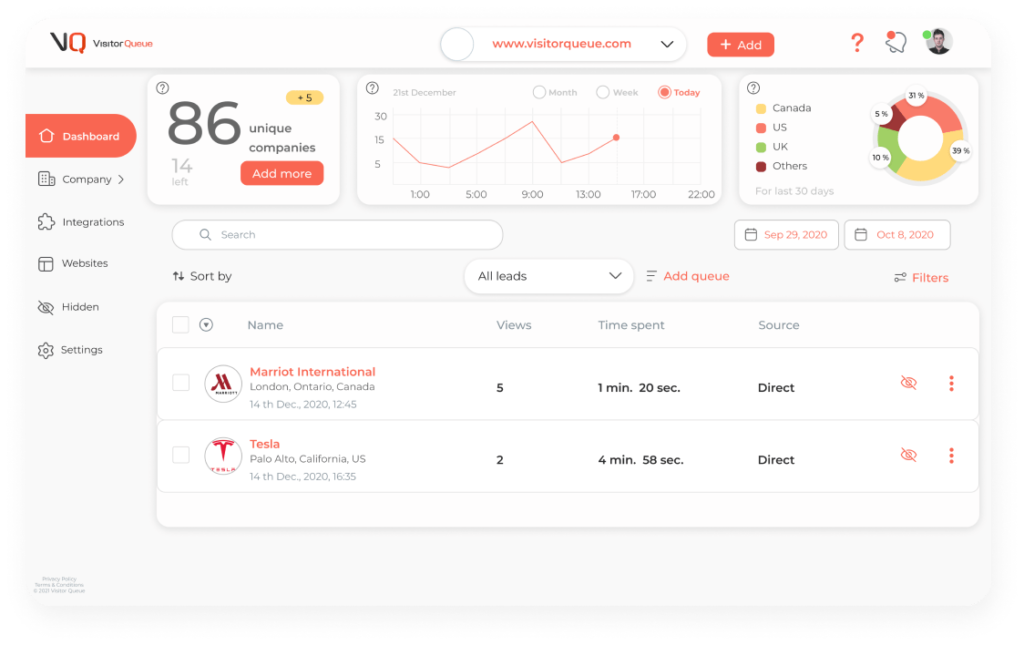Understanding the differences between a marketing qualified lead and sales qualified lead is crucial. Yet, so many B2B companies overlook them. It’s also crucial to understand for the overall success of your company. In this guide, we are going to go through what MQLs and SQLs are, and how to turn an MQL into an SQL, guiding them closer to the point of conversion. First, it’s important to understand what a sales funnel is.
What is a Sales Funnel?
Before jumping into the comparison of marketing qualified lead vs sales qualified lead, it’s important to understand what a sales funnel is. A sales funnel is a visual representation of your customer journey, from the initial awareness stage to the final conversion stage. At the tp of the funnel, a large number of potential customers are introduced to your company through various marketing efforts. These are your marketing qualified leads. As these prospects engage with your company, they progress down the funnel, turning into sales qualified leads. Understanding your own sales funnel can help you understand and optimize your lead generation and conversion processes. Not to mention, ensuring that your marketing and sales teams are aligned. Now that you know what a sales funnel is, let’s jump into what a marketing qualified lead is.
What is a Marketing Qualified Lead?
A marketing qualified lead, or MQL, is someone who has shown interest in your company by engaging with marketing efforts. They could show their interest by engaging with your social media content, downloading content, attending a webinar, subscribing to a newsletter, etc. However, they haven’t yet demonstrated that they are ready to make a purchase. MQLs can be nurtured through targeted marketing campaigns that provide additional information, guiding them further down your sales funnel. Here are a few ways that you can generate marketing qualified leads.
Webinars
Webinars are a great way to generate marketing leads. Choose a webinar topic that is relatable to your audience and is enticing. For example, as a lead generation company, we could put on a webinar that depicts 10 different ways to generate leads. Online events not only showcase your expertise, but also provide an opportunity for your audience to engage with you. Collect registration information of attendees, and follow up with them afterwards with additional supporting content. Take a look at this article How to Host a Webinar and Generate Leads to learn more.
Gated Content
Gated content, like eBooks and whitepapers, are a great way to offer exclusive content in exchange for contact information. By providing something valuable to your audience, you can peak their interest and begin nurturing them as leads through targeted email campaigns. You can advertise your gated content via email, paid social ads, organic social content, or with banner ads within relevant blog articles.

Social Media Engagement
Social media is one of the best ways to generate marketing qualified leads. Engage with your audience on social media platforms by sharing information content, promotions, blog articles, company information, and more. This can help you get in front of potential customers in a conversational way. You can also use paid social media advertising to retarget your followers, people who have engaged, and people who have similar characteristics to try and generate more leads.
What is a Sales Qualified Lead?
On the other hand, sales qualified leads, or SQLs, are prospects who have progressed further down your sales funnel. These leads have typically been vetted by your sales team or have had multiple points of contact with your business. SQLs are ready for personalized outreach, with the purpose of moving them toward the point of conversion. Here are a few examples of points of contact that SQLs.
Demo Requests and Free Trials
If a prospect is requesting a demo or starting a free trial, you know they are interested in what you have to offer. But, they have yet to pull the trigger. Use these opportunities to showcase the value of your product, and guide your prospects towards the point of purchasing. When you have prospects requesting a demo or starting a free trial, it’s crucial to ensure they are properly followed up with and have all of the information they need to succeed.
Website Visitor Identification
If you know that a prospect is visiting your pricing page or a competitor comparison page, there’s a good chance that they are fairly qualified. With the help of Visitor Queue, discover what companies are visiting your site, along with what pages they viewed, how long they spent on each page, and how they were acquired. This can help you gauge how interested your website visitors are. Plus, we also provide employee contact information to help you reach out and ensure they found what they are looking for. Try Visitor Queue for free today and stop losing leads.

Lead Scoring
Try to implement lead scoring based on criteria like demographics, firmographics, engagement level, and behavior. Assign higher scores to leads who demonstrate a higher likelihood of purchasing. This could include multiple website visits, content downloads, and interactions. Then, you can focus your sales efforts on those who are going to more likely to convert into paying customers. Most CRMs will have the option to set up lead scoring, helping you properly track where your contacts are in your sales funnel.
Moving a Lead From MQL to SQL
Now, you’re probably wondering how to move a marketing qualified lead to a sales qualified lead, and then conversion. Here is how you can transition a lead from MQL to SQL.
Understanding Your MQL to SQL Conversion Rate
In order to understand if your marketing and sales efforts are complimenting each other, you’ll need to calculate your MQL to SQL conversion rate. To calculate this, divide the total number of marketing qualified leads by the total number of sales qualified leads. Then, multiply it by 100. For example, say you generated 300 marketing qualified leads and 500 sales qualified leads last month. Your MQL to SQL conversion rate would be (300/500)*100, resulting in 60%. According to a study done by Salesforce, the average MQL to SQL conversion rate is 13%.
Implement Lead Nurture Campaigns
It takes an average of 8 touchpoints for a lead to convert into a paying customer. Knowing this, it’s important to ensure your marketing is continuously making contact with your audience. Develop targeted campaigns tailored to the specific needs and interests of your MQLs, providing them with relevant content and resources. You can use marketing automation tools to deliver personalized email workflows, drip campaigns, and retargeting ads that guide MQLs through your sales funnel. And, keep your brand at the top of their mind. Take a look at How to Implement a Successful Lead Nurturing Strategy to learn more.

Engagement Tracking
Monitor the behavior and interactions of your MQLs across various touchpoints, including website visits, content downloads, email opens, and social media engagement. Identify key indicators of purchase intent, including repeated visits to pricing pages, content downloads, or interactions with sales materials like a brochure download. By tracking this engagement, you can see what prospects are successfully moving down your sales funnel.
Ensure a Clear Sales Handoff
One of the most common complaints that I hear from sales teams is that they don’t know when a marketing qualified lead turns into a sales qualified lead. In other words, the sales team is unclear whether it’s time to step in yet. Because of this miscommunication, a lot of leads tend to fall through the cracks before they convert. Use lead scoring, engagement tracking, and manual review by sales and marketing to determine whether a lead meets the qualifications to become an SQL. Once a lead qualifies as an SQL, initiate the handoff process from marketing to sales. Notify your sales team about the qualified lead and provide them with relevant information like the lead’s activity history, engagement level, and content they have consumed. If you’re using a CRM like HubSpot or Salesforce, this process can be automated.
Sales Qualification and Next Steps
After a lead is handed over to the sales team, it’s time to conduct discovery calls to further understand their needs, budget, decision-making, and timeline. It’s important to confirm that the lead aligns with your company’s ideal customer profile. For example, if they are an SMB without the budget necessary for your software, they may not be ready to convert. Here, your sales team needs to establish clear next steps and a timeline for further engagement. This can include scheduling a demo, sending a proposal, or meeting with other decision makers within the company.
What’s Next?
When you have both marketing and sales teams, it can be difficult to know where your MQLs turn into SQLs. It’s important to keep in mind that regular communication and collaboration between marketing and sales teams are crucial to ensuring a seamless transition between the two. Keep in mind that there can be a lot of trial and error when it comes to building your sales funnel, and that it can always keep changing. As always, if you have any questions about using Visitor Queue to identify your website traffic, do not hesitate to reach out.
 Identify
Identify Personalize
Personalize Benchmark
Benchmark Agencies
Agencies Integrations
Integrations Case Studies
Case Studies Use Cases
Use Cases Blog
Blog Resources
Resources


















